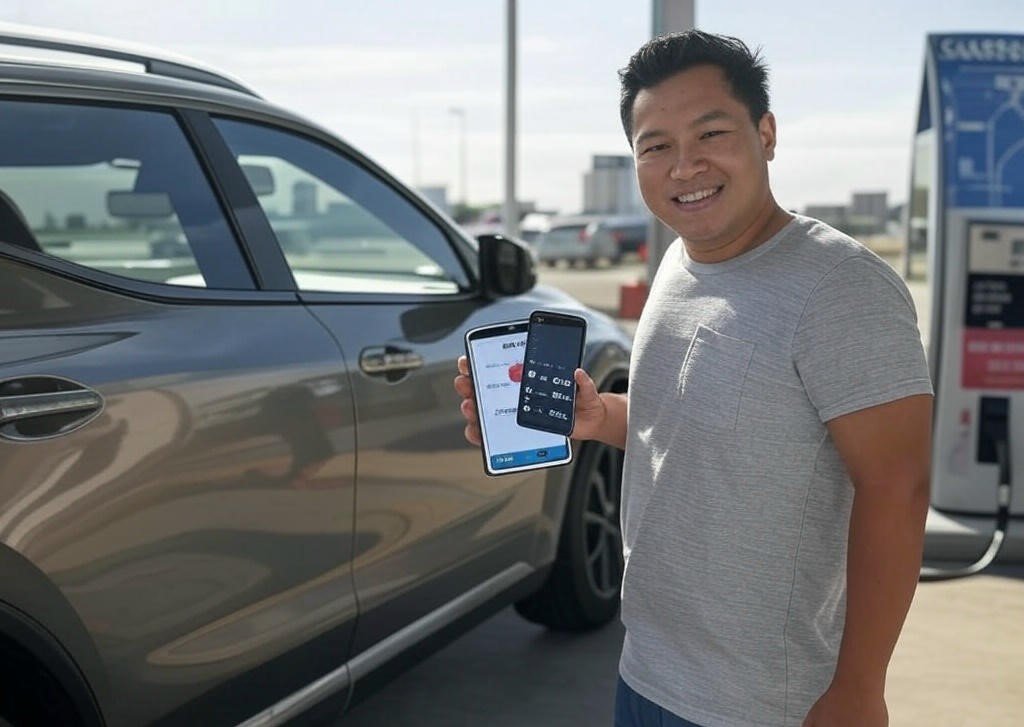How to Budget for Gas on a Tight Schedule

Introduction
Budgeting for gas on a tight schedule is a lifesaver when you’re juggling work, errands, and life’s endless demands. With fuel prices hovering around $3.50 per gallon in early 2025, according to AAA, every trip to the pump can feel like a hit to your wallet. Whether you’re a daily commuter or planning a summer 2025 road trip, mastering gas saving tips and fuel cost management can stretch your dollars further. This guide dives into practical, time-efficient strategies for budget-friendly driving and gas expense tracking, so you can save money without slowing down. I’ll share a personal story of how I cut my gas bill during a chaotic workweek—trust me, these hacks are total game-changers! From apps to driving habits, we’ve got you covered with actionable advice to keep your tank and budget full.
Why Gas Budgeting Matters in 2025
Rising fuel costs and packed schedules make budgeting for gas more critical than ever. The U.S. Energy Information Administration predicts gas prices could climb to $3.80 per gallon by mid-2025, especially during summer travel season. For busy folks, overspending at the pump is easy when you’re rushing between meetings or chauffeuring kids. Budgeting for gas isn’t just about saving a few bucks—it’s about gaining financial control and reducing stress. Plus, many gas saving tips double as eco-friendly habits, helping you cut your carbon footprint.
- Inflation’s Impact: Global demand and supply chain issues are driving fuel prices up.
- Time Crunch: Tight schedules leave little room to hunt for deals or plan efficient routes.
- Sustainability Bonus: Budget-friendly driving often means less fuel waste, aligning with 2025’s push for greener habits.
Proactively managing gas expenses lets you prioritize essential trips and avoid wasteful spending. For example, I used to fill up whenever I was near a station, but tracking my costs showed I was overspending by $20 a month. That’s coffee money!
Understanding Your Gas Spending Patterns
Before you can budget for gas, you need to know where your money’s going. Gas expense tracking is the foundation of smart fuel cost management. By analyzing your driving habits, you can spot inefficiencies and set a realistic budget that fits your busy life.
Track Your Fuel Purchases
Start by logging every fill-up with apps like Fuelio or GasBuddy. These tools record gallons, costs, and mileage, revealing patterns you might miss. For instance, I discovered I was refueling three times a week because I kept topping off during rushed errands. Consolidating trips saved me time and cash.
- How to Track: Note the date, gallons purchased, total cost, and odometer reading.
- Why It Helps: Identifies habits like frequent small fill-ups, which often cost more per gallon.
- App Features: Fuelio offers graphs to visualize spending, while GasBuddy compares local prices.
Calculate Your Monthly Gas Budget
Estimate your monthly fuel needs based on your commute, errands, and leisure trips. Divide your total spending by miles driven to find your cost per mile. This baseline helps you set a budget for gas that aligns with your schedule.
- Example Calculation: A 20-mile daily commute (400 miles/month) at 25 MPG and $3.50/gallon costs about $56/month. Add $30 for errands, and your budget is ~$86.
- Tip: Factor in seasonal spikes, like summer 2025 road trips, to avoid surprises.
Identify Wasteful Habits
Review your tracking data to spot inefficiencies. Are you idling in traffic? Making multiple short trips? These habits burn fuel fast. Adjusting them is a key step in fuel cost management.
- Common Culprits: Idling for 10 minutes daily can waste a gallon every two weeks, per the EPA.
- Quick Fix: Turn off your engine during long waits, like at school pickups.
Gas Saving Tips for Busy Schedules
When your calendar’s packed, gas saving tips need to be quick and effective. These strategies fit seamlessly into your routine, helping you save fuel without overhauling your life.
Optimize Your Driving Habits
Smooth driving is a budget-friendly driving hack that saves up to 20% on fuel, according to the EPA. Avoid rapid acceleration and hard braking, which guzzle gas. I learned this the hard way during a hectic week of back-to-back meetings—easing off the gas pedal saved me half a tank!
- Coast to Stops: Gradually reduce speed when approaching lights or stop signs.
- Steady Speeds: Use cruise control on highways to maintain consistent fuel use.
- Avoid Idling: Turn off your engine during waits longer than 30 seconds.
Plan Efficient Routes
Combine errands into one trip and use apps like Waze or Google Maps to dodge traffic. Route planning cuts idle time and boosts budget-friendly driving, especially during rush hour.
- Pro Tip: Schedule errands during off-peak hours (e.g., mid-morning) to avoid congestion.
- Example: Grouping grocery runs with pharmacy pickups saved me 10 miles a week.
Carpool or Share Rides
If your schedule allows, carpool with coworkers or neighbors. Splitting gas costs is a direct way to budget for gas while cutting trips.
- How to Start: Use apps like Scoop to find carpool matches in your area.
- Bonus: Fewer cars on the road mean less traffic and a greener commute.
Leveraging Technology for Fuel Cost Management
Technology makes gas budgeting easier, especially when time is short. From price comparison apps to real-time mileage trackers, these tools streamline fuel cost management for busy drivers.
Use Gas Price Comparison Apps
Apps like GasBuddy and Upside find the cheapest stations near you. Checking prices before filling up can save 10–25 cents per gallon, adding up fast.
- GasBuddy: Shows real-time prices and loyalty discounts at nearby stations.
- Upside: Offers cashback on gas purchases, redeemable via PayPal or gift cards.
- Tip: Compare prices during your commute to plan fill-ups strategically.
Monitor Real-Time Fuel Consumption
Many modern cars have fuel economy displays on the dashboard. Use them to adjust driving habits on the fly, enhancing budget-friendly driving.
- Personal Anecdote: My car’s display showed I was burning more fuel in stop-and-go traffic, so I switched to less congested routes, saving $15 a month.
- How to Use: Check your MPG after each trip to identify inefficient routes or habits.
Automate Expense Tracking
Apps like Fuelly sync with your car’s odometer or GPS to log trips and expenses automatically. This saves time and ensures accurate gas expense tracking.
- Features: Fuelly offers mileage reports and budget alerts.
- Benefit: Frees up mental space for your busy schedule.
Comparison of Gas-Saving Tools and Apps
Choosing the right tools can supercharge your gas budgeting efforts. Below is a comparison table of popular apps and tools to help you pick the best fit for your needs.
Gas-Saving Tools Comparison
| Tool/App | Cost | Features | Best For | Ease of Use | Savings Potential |
|---|---|---|---|---|---|
| GasBuddy | Free | Price comparison, trip planner | Finding cheap gas | High | High |
| Fuelio | Free | Mileage and expense tracking | Detailed budgeting | Medium | Medium |
| Waze | Free | Route optimization, traffic alerts | Busy commuters | High | Medium |
| MyCarTracks | Free/Premium | GPS-based mileage tracking | Freelancers, business drivers | Medium | Medium |
| Fuelly | Free | Fuel log, analytics | Long-term budgeting | High | Medium |
This table highlights tools that align with gas expense tracking and fuel cost management, making them ideal for tight schedules. For example, GasBuddy is perfect for quick price checks, while Fuelio suits those who want detailed analytics.
Budget-Friendly Driving for Seasonal Travel
Summer 2025 is prime time for road trips, but fuel costs can spiral without a plan. These budget-friendly driving tips ensure you save gas during peak travel seasons.
Prep Your Vehicle for Efficiency
Regular maintenance boosts fuel efficiency by up to 10%, per the U.S. Department of Energy. Check tire pressure, air filters, and oil before hitting the road.
- Maintenance Checklist:
- Inflate tires to the recommended PSI (check your car’s manual).
- Replace clogged air filters to improve engine performance.
- Use the right motor oil for your vehicle.
- Impact: Properly inflated tires alone can save 3% on fuel.
Pack Light to Save Fuel
Extra weight lowers mileage, especially on long drives. Remove unnecessary items from your trunk or roof rack to cut gas costs.
- Example: Ditching old camping gear from my SUV saved me $10 on a weekend trip to the mountains.
- Rule of Thumb: Every 100 pounds removed improves MPG by 1–2%.
Plan Fuel Stops in Advance
Use GasBuddy to map out cheap stations along your route. This prevents last-minute fill-ups at overpriced pumps, a common budget buster.
- Tip: Look for stations near rest stops to combine breaks and refueling.
Case Study: How Sarah Saved $50 a Month on Gas
Sarah, a 32-year-old mom and part-time freelancer, was spending $200 a month on gas due to erratic driving and poor planning. Her busy schedule—school drop-offs, client meetings, and grocery runs—left no time for fuel cost management. After adopting gas saving tips, she cut her bill by 25%. She used GasBuddy to find stations with prices as low as $3.20/gallon, consolidated errands into one weekly trip, and tracked expenses with Fuelio. Sarah also switched to smoother driving habits, saving half a gallon per week. Emotionally, she felt empowered knowing she could stretch her budget for family outings, like a summer 2025 beach trip. Her story proves small changes can yield big savings, even with a packed calendar.
Emerging Trends in Gas Budgeting for 2025
New technologies and policies are reshaping how we budget for gas. Staying ahead of these trends can maximize your savings in 2025 and beyond.
- Plug-In Hybrids: Affordable hybrid models, like the 2025 Toyota Prius, offer gas savings for short commutes.
- Fuel Rebate Programs: Apps like Upside and GetUpside provide cashback, with some users saving $100 annually.
- AI Route Planners: Google Maps’ 2025 update predicts fuel-efficient routes based on traffic and terrain, enhancing budget-friendly driving.
- Policy Shifts: Federal incentives for fuel-efficient vehicles could lower costs for hybrid or electric car buyers by mid-2025.
These trends make budgeting for gas more dynamic, blending tech and policy to save you money.
FAQs About Budgeting for Gas
Conclusion
Budgeting for gas on a tight schedule is entirely doable with the right strategies. By embracing gas saving tips, leveraging gas expense tracking apps like Fuelio, and adopting budget-friendly driving habits, you can cut fuel costs without disrupting your busy life. From optimizing routes to prepping your car for summer 2025 road trips, these steps empower you to take control of your finances. Don’t let high gas prices stress you out—start today! Grab our free guide on how to budget for gas and drive smarter in 2025!






